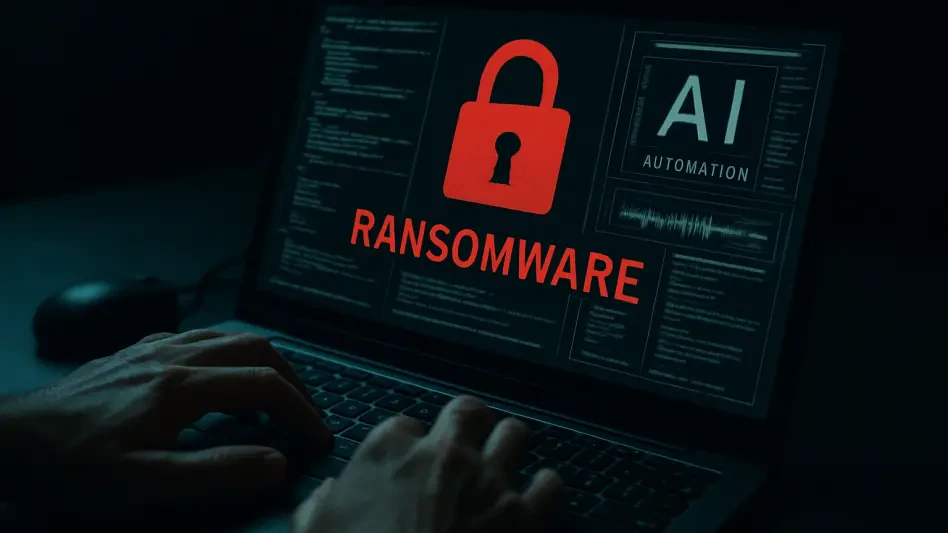In the ever-evolving landscape of cybercrime, a disturbing trend has emerged where ransomware-as-a-service (RaaS) groups are leveraging cutting-edge technology to amplify their destructive potential, with artificial intelligence (AI) becoming a game-changer for these malicious entities. AI enables them to streamline operations, accelerate attacks, and attract a wider pool of affiliates eager to exploit vulnerabilities. This technological shift is not merely a tool for efficiency but a strategic weapon that is reshaping the competitive dynamics within the underground economy of cybercrime. As AI-powered automation becomes more accessible, the speed and sophistication of ransomware attacks are reaching unprecedented levels, posing a significant challenge to cybersecurity defenses worldwide. The implications of this development are profound, as organizations struggle to keep pace with threats that evolve at an alarming rate, driven by algorithms that optimize every stage of an attack. This growing reliance on AI signals a new era of digital danger, where the line between innovation and exploitation continues to blur.
The Rise of AI in Ransomware Operations
The integration of AI into ransomware operations has dramatically transformed the efficiency with which RaaS groups execute their attacks. Advanced tools powered by AI have slashed the time it takes for cybercriminals to move from initial access to compromising additional devices, a metric known as “breakout time.” Recent data indicates that this duration has dropped significantly in recent months, allowing attackers to infiltrate systems and deploy ransomware at a pace that leaves defenders scrambling. These tools often include capabilities such as evading antivirus software and automating the disabling of protective mechanisms that could thwart ransomware execution. Such advancements not only make attacks more effective but also reduce the technical expertise required to carry them out, lowering the barrier for entry for potential affiliates. As a result, RaaS groups can scale their operations rapidly, targeting a broader range of victims with minimal effort while maximizing damage.
Beyond speed, AI-driven automation enhances the overall appeal of RaaS programs to prospective partners in crime. By offering user-friendly interfaces and sophisticated functionalities, these groups position themselves as attractive business propositions in the cybercrime ecosystem. Affiliates benefit from pre-built tools that simplify complex attack processes, enabling even less experienced operators to achieve high-impact results. This democratization of advanced technology fosters a competitive environment where RaaS groups must continuously innovate to maintain or grow their market share. The ability to provide cutting-edge automation has become a key differentiator, drawing in affiliates who seek reliable and efficient platforms to execute their schemes. This trend underscores a broader shift in cybercrime, where technological prowess is as critical as traditional criminal tactics in determining success.
Competitive Edge Through Technological Innovation
In the crowded field of RaaS, AI-powered automation serves as a crucial factor separating thriving groups from those struggling to survive. Groups that have embraced these technologies are witnessing accelerated growth and a surge in affiliate recruitment, outpacing competitors who lag behind in adopting such tools. For instance, certain well-known RaaS operators have managed to rebuild their influence after setbacks by integrating advanced AI capabilities, thereby restoring confidence among their affiliate networks. In contrast, groups lacking these innovations are seeing a decline in activity, with fewer victims reported on their data-leak platforms. This disparity highlights how technology acts as a catalyst for market dominance, enabling innovative groups to capture a larger share of the illicit profits that fuel their operations and further invest in cutting-edge tools.
Emerging players in the RaaS space are also capitalizing on AI to establish themselves quickly among established competitors. Newer groups have gained traction by offering sophisticated automation features right from their inception, naming numerous victims on their leak sites within weeks of launching. Others have seen their victim counts rise dramatically over a short period, largely attributed to the adoption of advanced technological offerings that streamline attack processes. This rapid rise of tech-savvy newcomers illustrates a broader trend where automation is not just an enhancement but a prerequisite for relevance in the ransomware market. However, the adoption of AI tools remains uneven, with only a portion of RaaS groups currently providing these capabilities to affiliates. This gap suggests that the full impact of AI on the ransomware landscape is yet to be realized, as more groups are likely to follow suit in the coming years.
Evolving Threats and Cybersecurity Challenges
The proliferation of AI-fueled automation within RaaS groups is reshaping the threat landscape, presenting new hurdles for cybersecurity professionals tasked with defending against these attacks. Security researchers have noted that the speed and precision enabled by AI tools are amplifying the risk to organizations, as attackers can execute complex campaigns with minimal human intervention. This automation allows for rapid adaptation to defensive measures, making it harder for traditional security protocols to keep up with evolving tactics. The result is an escalating arms race between cybercriminals and defenders, where the former continuously refine their methods to exploit vulnerabilities before patches or mitigations can be deployed. This dynamic underscores the urgent need for innovative approaches to cybersecurity that can match the pace of AI-driven threats.
While AI offers cybercriminals a significant advantage, it also reveals a critical vulnerability in the current state of digital defense strategies. Many organizations remain unprepared for the sophistication and speed of automated ransomware attacks, often relying on outdated systems that fail to detect or respond to threats in real time. The consensus among experts is that while AI is a powerful tool for attackers, it also presents an opportunity for defenders to develop equally advanced countermeasures. However, the limited adoption of such technologies by RaaS groups indicates that the threat landscape is still in flux, with potential for even greater challenges ahead. Addressing this evolving risk requires a proactive shift in cybersecurity practices, focusing on predictive analytics and automated response systems to counter the relentless innovation of ransomware operators.
Navigating the Future of Digital Defense
Looking back, the rapid integration of AI into ransomware operations marked a turning point for cybercrime, as groups harnessed automation to outmaneuver traditional defenses with unprecedented efficiency. The contrasting fates of various RaaS operators demonstrated how technological adoption became a defining factor in their success or decline. As the dust settled on this transformative period, it became evident that the cybersecurity community had to rethink its approach to combat these enhanced threats. Moving forward, organizations must prioritize the development of AI-driven defense mechanisms that can anticipate and neutralize attacks before they escalate. Investing in real-time threat intelligence and fostering collaboration across industries will be essential to stay ahead of cybercriminals. By embracing innovation and adapting to the automated tactics of RaaS groups, defenders can build a more resilient digital ecosystem capable of withstanding the challenges posed by this new era of cybercrime.








